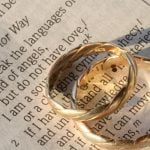What finger is a wedding ring worn on? The significance of wedding rings and the tradition behind wearing them on a specific finger have been important cultural and personal symbols for centuries. From ancient origins to modern trends and personal preferences, the placement of a wedding ring holds deep meaning for many. In this article, we will explore the history, cultural differences, symbolism, and personal significance of wearing a wedding ring on a specific finger.
The tradition of exchanging wedding rings dates back to ancient Egypt and has evolved over time to become a widespread custom across cultures. Different cultures have varying customs when it comes to wearing wedding rings and which finger they are worn on, reflecting the diverse traditions and beliefs around marriage and commitment. Understanding these cultural differences adds depth to the significance of where a wedding ring is placed.
Each finger has its own symbolism associated with it when it comes to wearing a wedding ring, with different fingers representing various meanings. One of the most popular traditions is wearing the wedding ring on the fourth finger of the left hand, known as the “ring finger.” This tradition has deep roots in symbolism and historical significance that continue to influence modern trends in wedding customs.
History of Wedding Rings
The tradition of wearing wedding rings dates back thousands of years, with evidence of ancient civilizations exchanging rings as a symbol of commitment and unity. The earliest known examples can be traced back to ancient Egypt, where reed or hemp rings were exchanged as a symbol of eternity. Over time, the materials and designs of wedding rings evolved, with the Romans being the first to popularize the use of metal bands for wedding rings.
Evolution of Wedding Rings
As cultures and traditions spread, so did the practice of exchanging wedding rings. In medieval Europe, the trend of inscribing romantic sentiments on the inside of wedding bands began to emerge, adding a new layer of sentimentality to the tradition. The symbolism behind the circular shape of a ring representing eternal love and unity also became widely accepted during this time.
Shifting Customs
Throughout history, different cultures have had varying customs when it comes to wedding rings and which finger they should be worn on. For example, in some Eastern European countries, it is tradition for men to wear their wedding ring on their right hand rather than their left. Additionally, in some cultures, the type of metal used for the wedding ring holds significant meaning.
As weddings become increasingly diverse and multicultural, couples are drawing inspiration from various traditions and adapting them to create their own unique customs when it comes to exchanging and wearing wedding rings.
Cultural Differences
Wedding ring traditions vary greatly across different cultures, with each one having its own customs and significance. Understanding these cultural differences can provide valuable insights into the diversity of wedding ring traditions around the world.
Here are some examples of cultural differences in wedding ring customs:
- In Western cultures, such as the United States and most European countries, the wedding ring is traditionally worn on the fourth finger of the left hand. This tradition dates back to ancient Rome when it was believed that the “vena amoris” or “vein of love” ran directly from this finger to the heart.
- In many Eastern cultures, including India and Indonesia, the wedding ring is often worn on the right hand instead of the left hand. This is due to cultural and religious traditions that prioritize the right hand for rituals and ceremonies.
- In some African cultures, wedding rings are not commonly exchanged. Instead, other symbolic items such as bracelets or necklaces may be used to represent marriage and commitment.
Understanding these cultural differences can bring a greater appreciation for the diversity of wedding ring traditions around the world and highlight how personal and cultural preferences play a significant role in determining which finger a wedding ring is worn on.
Symbolism of Each Finger
When it comes to wearing a wedding ring, the choice of finger holds significant cultural and symbolic meaning. While the tradition of wearing a wedding ring on the fourth finger is most common in many cultures, each finger has its own symbolism associated with it.
The symbolism of wearing a wedding ring on different fingers can vary widely across different cultures. In Western traditions, the fourth finger of the left hand, also known as the “ring finger,” is believed to have a direct vein that leads straight to the heart, symbolizing love and commitment. On the other hand, in some Eastern cultures, the right hand is preferred for wearing wedding rings, with each finger representing various aspects such as family, society or spirituality.
In addition to cultural differences, there are also personal and individual reasons for choosing which finger to wear a wedding ring on. Some people may have personal preferences based on comfort or aesthetic appeal, while others may choose to honor familial or religious traditions that dictate a specific finger for their wedding ring.
– There is no one-size-fits-all answer to the question “what finger is a wedding ring worn on.” However, understanding the symbolism behind each finger and being aware of different cultural customs can help individuals make an informed decision about where they choose to wear their wedding ring. By considering personal preferences alongside historical and cultural significance, couples can ensure that their choice reflects not only their love and commitment but also their individual beliefs and values.
The Tradition of the Fourth Finger
It is widely known that in many cultures, the tradition of wearing a wedding ring on the fourth finger of the left hand is prevalent. This tradition has deep historical and symbolic significance, with roots dating back to ancient times. The fourth finger, also known as the ring finger, has been associated with love and commitment for centuries, making it a popular choice for wearing the symbol of marriage.
This romantic notion added to the symbolism of this specific finger as being closely connected to matters of love and affection, making it an ideal choice for carrying a symbol of marital commitment.
In addition to its historical symbolism, another reason behind this tradition is its widespread adoption throughout various cultures. Over time, this custom has become deeply ingrained in many societies around the world, leading to the almost universal practice of wearing wedding rings on the fourth finger. Despite cultural differences in other aspects of weddings and marriage traditions, this particular practice remains consistently observed.
Modern Trends
In recent years, there has been a noticeable shift in the traditional customs of wearing wedding rings, with modern trends reflecting changing attitudes towards the significance of different fingers for ring placement. This shift is often influenced by cultural diversity, individual preferences, and contemporary fashion trends.
Cultural Diversity and Individual Preferences
Cultural diversity plays a significant role in modern trends regarding the wearing of wedding rings. In some cultures, there are no set rules about which finger a wedding ring should be worn on, allowing individuals to make their own choices based on personal preference.
This flexibility has led to a growing trend of couples choosing alternative fingers as a way to honor their heritage or symbolize personal meaning. Additionally, individual preferences also play a crucial role in modern trends, with many people opting for unconventional ways of wearing wedding rings that reflect their unique personalities.
Changing Fashion Trends
Fashion trends have also influenced how wedding rings are worn in modern times. With the rise of non-traditional jewelry styles and designs, couples are exploring new ways to showcase their commitment through unique ring placements. This includes stacking multiple rings on different fingers or choosing asymmetrical designs that deviate from the classic placement on the fourth finger. As such, the significance of wearing a wedding ring on a specific finger is evolving alongside contemporary fashion influences.
Personalization and Symbolism
Another prevalent modern trend is the emphasis on personalization and symbolism when it comes to choosing which finger to wear a wedding ring on. Many couples prioritize the sentimental value and emotional resonance behind their ring placement, often incorporating symbols or engravings that hold special meaning for them. This personalized approach underscores the idea that the significance of wearing a wedding ring transcends traditional guidelines and instead reflects the unique bond between partners.
As these modern trends continue to shape the landscape of wedding ring customs, it becomes clear that there is no longer a definitive answer to “what finger is a wedding ring worn on,” highlighting the diverse array of choices and meanings associated with this symbolic tradition.
Personal Preferences
Many people may wonder what finger is a wedding ring worn on, and while tradition and culture play a significant role in determining this, personal preferences also come into play. In current times, individuals are increasingly making their own choices when it comes to wearing wedding rings. Some may choose to follow the traditional customs of their culture or religion, while others opt for a different approach based on their personal beliefs and preferences.
For some, the choice of finger for wearing a wedding ring is tied to practicality and comfort. The dominant hand may impact this decision, as those who use their left hand more often might choose to wear their wedding ring on the right hand for ease of movement and reduced wear and tear. Additionally, factors such as the size and shape of one’s fingers can influence where the wedding ring feels most comfortable.
Furthermore, personal symbolism also plays a crucial role in deciding which finger to wear a wedding ring on. Some individuals may have cultural or family traditions that dictate the finger on which the wedding ring should be worn but may choose to deviate from these traditions due to personal significance attached to another finger. Ultimately, personal preferences create flexibility when it comes to choosing the finger for wearing a wedding ring.
| Wedding Ring Finger | Reasons for Choice |
|---|---|
| Left Hand Ring Finger | Traditional significance or family custom |
| Right Hand Ring Finger | Practicality and dominant hand preference |
| Other Fingers | Personal symbolism or comfort reasons |
Conclusion
In conclusion, the significance of wearing a wedding ring on a specific finger goes beyond just tradition. It reflects personal and cultural values that have been passed down through generations. From the ancient origins of the tradition to modern trends, the choice of which finger to wear a wedding ring on holds deep symbolic meaning. Understanding this significance is important in appreciating the depth of this timeless tradition.
While the fourth finger of the left hand has become widely recognized as the traditional finger for wearing a wedding ring, it’s important to acknowledge that cultural differences play a significant role in determining which finger is chosen for this symbolic piece of jewelry. Different cultures have varying customs when it comes to wearing wedding rings, and these traditions are deeply rooted in history and symbolism.
Ultimately, personal preferences also play a role in deciding which finger to wear a wedding ring on. Whether it’s following long-standing cultural traditions or choosing a finger based on personal symbolism, the decision holds importance to each individual. The act of wearing a wedding ring is not just about adornment; it carries with it layers of meaning and serves as a reflection of personal identity and cultural heritage.
Frequently Asked Questions
Why Do You Wear Wedding Ring on Right Hand?
Wedding rings are traditionally worn on the right hand in certain cultures such as those in Eastern Europe and India. This tradition dates back centuries and varies from culture to culture, with some associating the right hand with masculinity and strength.
Is the Engagement Ring on the Left or Right Hand?
The engagement ring is typically worn on the left hand, specifically on the ring finger. In Western cultures, this tradition stems from ancient beliefs that a vein in the fourth finger of the left hand, known as the “vena amoris,” is directly connected to the heart.
Why Do You Wear Your Wedding Ring on Your Left Hand?
The custom of wearing a wedding ring on the left hand is believed to have originated from ancient Egypt, where it was thought that a vein ran directly from the fourth finger on the left hand to the heart. This symbolized eternal love and commitment, influencing the placement of wedding rings today.

Welcome to my blog about home and family. This blog is a place where I will share my thoughts, ideas, and experiences related to these important topics. I am a stay-at-home mom with two young children. I hope you enjoy reading it! and may find some helpful tips and ideas that will make your home and family life even better!





